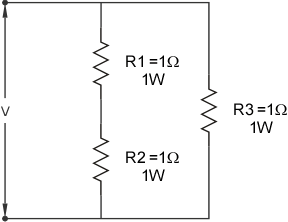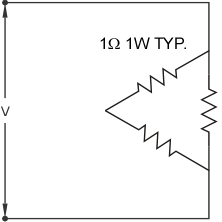Why?Oh, I get your point. My point is?quite simply?it is wrong.
1.5W. Due to R1 and R2 in series.So entertain me. Answer this (and don't jump off topic)...
What is the wattage capacity of the following circuit and why is it not 3W?

Why?Oh, I get your point. My point is?quite simply?it is wrong.
1.5W. Due to R1 and R2 in series.So entertain me. Answer this (and don't jump off topic)...
What is the wattage capacity of the following circuit and why is it not 3W?

We'll get to that.Why?
1.5W. Due to R1 and R2 in series.

I agree. The same is true for a 3? transformer... but not a bank of 3 single-phase transformers. Nevertheless, many more considerations would go into calculating the generator's actual limit than simple V*I ratios as presented by Sahib.I think that there is a basic point being missed here.
The generator design, like most electrical kit, has to deal with losses. That, essentially, is what determines rating. If you want to conduct 20A you size the conductor accordingly. Make it too small and it overheat. Make it unnecessarily large and you waste material.
So the generator is sized to dissipate losses. Give it a balanced load and all three of the delta connected windings are loaded equally. Load it with single phase and you no longer have that balance. The windings will no longer be loaded equally. One winding will take more current and get hotter than the others. It can obviously take up to its rated current but beyond that? Probably so. The cooling for all three windings at rated load is still there even if two of the windings are taking less than rated current thus running below rated temperature. This allows heatsink capacity for the other, more heavily loaded winding.
In short, I don't think you can just use rated winding rated current as a simple measure of single phase capacity.
typo... should have been 1/4W.... Its wattage limit is reached while R1 and R2 are at only 1/2W each.
...
No, I'd say I'm done with this one. ...
... What the Basler paper shows is that the rotor is rotating in one direction but the magnetic flux is rotating in the other. This cutting of the flux induces currents in the rotor that cause it to heat up.
I agree. The same is true for a 3? transformer... but not a bank of 3 single-phase transformers.
many more considerations would go into calculating the generator's actual limit than simple V*I ratios as presented by Sahib.
Consideration of the thermal capacity.So what more clarification is required?
As Besoeker stated...I do not know what you are talking about. It should hold true irrespective of whether it is a 3? transformer or a bank of 3 single-phase transformers.
Let me first sort out any confusions.
1) The single phase capacity of a delta connected generator is 57% of its three phase capacity as worked out also in post#79, provided that
2) The generator so supplying a single phase load of its line current rating is checked to be not damaged by any negative sequence currents as pointed out in post#45.
So what more clarification is required?
Consideration of the thermal capacity.
I stated that the single phase load shall not exceed the line current capacity of the delta connected generator. So any resulting negative sequence circulating current in the winding of the generator may be calculated using symmetrical components method and checked with relevant IEEE standard for permissible limits...
The calculations you have shown (regardless of correctness) are based on 3? rating, whether we break it down to the rating of each winding or not. That rating is based mostly on the maximum 3? load which the generator will handle without advancing normal degradation. The largest contributing factor to advanced degradation on overload is heat.
Abnormal circulating current is the cause of winding damage whether it be a 3 phase transformer or it is a bank of 3 single phase transformers.When you have windings integrated in a single unit, thermal capacity is shared. As Bes' pointed out earlier, single phase loading heats the windings unevenly, but the ability to dissipate the heat is still shared. Heat generated by the heaviest loaded winding is carries over into what would otherwise be used to diispate heat from the other windings when winding load is balanced. Same is true of a single-unit 3? transformer (e.g. common core). This should mean under single phase only loading, the heaviest loaded winding should be able to exceed one third the 3? rating without any premature degradation.
In the case of a bank of 3 single phase transformers, each unit does not have any significant shared thermal dissipation medium.
I can see where you are leading to. Your conclusion would be wrong, because of your generalization of DC to AC.So where is the answer to post #82...?
I admit I'm quite rusting on symmetrical component analysis... but I do understand the basics. I just cannot relate the calculation results to the physical phenomena as I could many, many years ago. Hence, I'm currently having a problem with understanding what you mean by "negative sequence circulating current"... coupled with...I stated that the single phase load shall not exceed the line current capacity of the delta connected generator. So any resulting negative sequence circulating current in the winding of the generator may be calculated using symmetrical components method and checked with relevant IEEE standard for permissible limits.
My understanding of circulating current on delta-configured windings is the current never leaves the windings, and thus does not get out on the lines and cannot be determined by line current analysis.Abnormal circulating current is the cause of winding damage whether it be a 3 phase transformer or it is a bank of 3 single phase transformers.
Your jumping to conclusions. DC or AC, the circuits apply to either. Any difference will be discussed when appropriate... that is, IF we ever get there.I can see where you are leading to. Your conclusion would be wrong, because of your generalization of DC to AC..
There you go again with that 1.732 factor. As I said earlier, 1.732 applies only to balanced 3? conditions... which powering a single phase load with a 3? generator is most definitely not!!!You are going to state the output power in your DC circuit is limited to 1.5W. Similarly for AC circuit, it is 1.5 times KVA of a phase. But it is not true, because the rated line current of delta connected generator is Iline and its rated voltage is Vline and so its rated single phase capacity is Vline*Iline. In other words, it is 1.732*Vline*Iphase, where Iphase is the rated phase current.
Yes. 1.732 applies only to balanced 3? conditions. So, here I applied it to the rated balanced three phase capacity of a delta connected generator: 1.732*Vline*Iline. Next I stated that the rated line current of a delta connected generator is Iline. So if a single phase load of current Iline is connected between two terminals of the delta connected generator, its rated line current of Iline will flow. But this Iline is 1.732 times rated phase current of the generator, irrespective of its actual phase current. So continuing the logic ( for the n-th timeThere you go again with that 1.732 factor. As I said earlier, 1.732 applies only to balanced 3? conditions... which powering a single phase load with a 3? generator is most definitely not!!!
You don't have to keep re-explaining. I completely understand what you did. Where I see fault is the red text in quote. There are three phase currents in delta-configured windings. Please demonstrate none of the three windings has an overcurrent condition, where Iphase = "3?-Iline"/1.732.Yes. 1.732 applies only to balanced 3? conditions. So, here I applied it to the rated balanced three phase capacity of a delta connected generator: 1.732*Vline*Iline. Next I stated that the rated line current of a delta connected generator is Iline. So if a single phase load of current Iline is connected between two terminals of the delta connected generator, its rated line current of Iline will flow. But this Iline is 1.732 times rated phase current of the generator, irrespective of its actual phase current. So continuing the logic ( for the n-th time), it may be seen that single phase capacity of the generator is 1.732 times rated KVA of its phase.
Please demonstrate none of the three windings has an overcurrent condition
:thumbsdown:I already gave an evidence of a generator manufacturer for the use of a delta connected three phase generator as a single phase generator at 57% of its three phase capacity in post#77.
Okay.:thumbsdown:
Abnormal circulating current is the cause of winding damage whether it be a 3 phase transformer or it is a bank of 3 single phase transformers.
Abnormal heat causes the damage.Heat causes the damage.
Gee, Sahib... I ask you a question about a simple resistor network and get nothing but subterfuge. And now you're asking me to do symmetrical component analysis... :blink:Okay.
Let us both try to apply the symmetrical components method to find whether that generator manufacturer is worthy of any business.
First the single phase load is connected only between any two terminals of the delta connected generator. So if the phase angle of current Iline from one terminal is taken as zero, the phase angle of the same return current through the other terminal should be taken as 180. The current through the third terminal is zero. So the negative sequence current I2 is given by
I2= [Iline(0)+(a*a)*Iline(180)]/3.............(1), where 'a' is complex operator.
Please calculate the value of I2 in (1) in terms of Iline to proceed further.
I think one might reasonably have inferred that from my post.Abnormal heat causes the damage.
